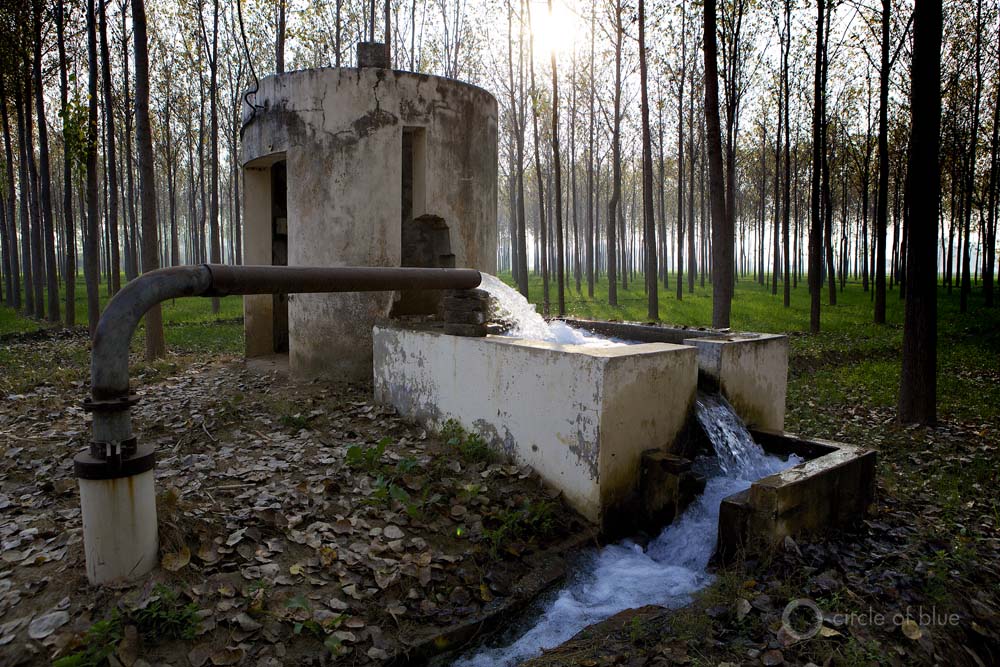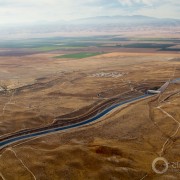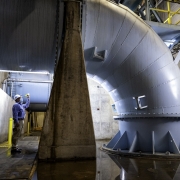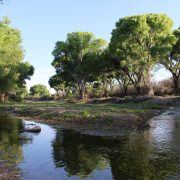National Groundwater Awareness Week: 21 Stories on the World’s Most Abundant Source of Liquid Freshwater
Circle of Blue reports on groundwater supplies and pollution from California and Texas to India and the Middle East.
How much have you thought about groundwater this week? For that matter, how much do you think about groundwater on any given week? Quite a bit, hopes the National Ground Water Association, the U.S. trade group that is once again sponsoring National Groundwater Awareness Week, which began on Sunday, March 8, and ends on Saturday, March 14.
Why is groundwater so important?
Crack open the earth’s crust, slice it from topsoil to deep bedrock, and you will likely find an aquifer. Some of these water-holding geologic layers are fine-grain sediments — sands and clays that act as a sponge. Other aquifers are limestone or basalt, and water courses through them like blood through veins.
Regardless of size and shape, they all hold a bounty. It is here, underground, that almost all the world’s liquid freshwater is held — some 96 percent of the water that isn’t frozen, according to a respected global assessment. Rivers, lakes, and streams, by comparison, are condensation on a pint glass.
Here in the United States, we use close to 288 million cubic meters (76 billion gallons) of fresh groundwater every day that is pumped from about 15.9 million wells, according to the NGWA. Irrigation is the largest user of U.S. groundwater — about 67.2 percent of total withdrawals from nearly 408,000 wells — but domestic residents are highly dependent upon groundwater, as well.
“Some 44 percent of the U.S. population depends on groundwater… for its drinking water supply — be it from either a public source or private well. In rural areas, the number is about 96 percent. That fact alone justifies the need for National Groundwater Awareness Week…”
–Kevin McCray, executive director of National Ground Water Association
Globally, groundwater plays a significant role in the production of the world’s food, fuel, and fiber. It is the source of half the world’s drinking water, according to the United Nations.
Moreover, aquifers are under increasing stress — the rate of groundwater withdrawals has tripled over the last 50 years.
At Circle of Blue, we’ve reported on groundwater, both in the United States and abroad, for years. Below is a sampling from our archive, organized by region and date.
Read these articles, share them, and let us know what you think about them and this week’s tagline — “Groundwater Awareness is important to you!” — on Facebook, or contact Brett Walton directly, or a tweet to @waltonwater, or comment below.
–Brett Walton, Circle of Blue reporter
United States
Report: Farming and Urban Growth Are Polluting U.S. Aquifers: One-fifth of U.S. groundwater wells had at least one contaminant above federal standards for human health, according to new USGS study. (January 23, 2015)
Infographic: California Drought Drains Groundwater Reserves and Encourages New Wells: Most aquifers in the state have dropped to record lows. (December 18, 2014)
California’s Dogged Drought Cutting Off Water Supplies to State’s Poor: Farmers are guzzling groundwater while wells of families run dry. (August 26, 2014)
In Apparent Contradiction, Data Shows Waukesha’s Groundwater Levels Rising, Not Falling: City’s case for diverting Great Lakes Water appears significantly weakened. (August 1, 2014)
In Colorado River Basin, Groundwater Is Disappearing Much Faster Than Lake Mead: Groundwater losses during historic drought equal one and a half times the volume of a full Lake Mead. (July 24, 2014)
Map: The Shrinking Ogallala Aquifer: Irrigation brought fat harvests to the plains. But the water is disappearing. (June 24, 2014)
Ogallala Aquifer: A Nation’s Precious Underground Water Supply (January 19, 2014)
Texas and Kansas Farmers Take Different Paths to Saving Water: Scuttling decades of habit, legal precedence, and cultural resistance, agriculture on the Great Plains reluctantly moves toward decisions on water use, crop yields, and profits that have been put off for decade. (January 19, 2014)
Report: Society’s Water Safety Net Is Fraying: A National Research Council report argues that groundwater use today is leaving society poorly prepared for potential rapid climate changes in the future. (December 5, 2013)
U.S. Groundwater Losses Between 1900-2008: Enough to Fill Lake Erie Twice: Groundwater depletion in the United States has accelerated over the last decade, according to the U.S. Geological Survey, contributing to both localized problems and global issues, like sea level rise. (May 16, 2013)
Texas High Plains Prepare for Agriculture without Irrigation: Southern farmers are making changes now to wean themselves from the Ogallala Aquifer, a water source that gave rise to industrial agriculture and modern life on America’s plains. (April 5, 2013)
Contaminated U.S. Groundwater Sites Will Cost $110 Billion to Clean, Report Says: State and federal regulators need to consider the cost of remediation, program success and public health. (November 9, 2012)
In These Dry Times, Groundwater Rescues New Mexico Farmers: Surface water allocations last year were 10 percent of normal, but record levels of groundwater pumping buoyed production in the state’s top agricultural region. (May 4, 2012)
Food vs. Water: High Commodity Prices Complicate Aquifer Protection in Colorado’s San Luis Valley: Decades of groundwater pumping have left one of the San Luis Valley aquifers in a perilous state. To restore its health — and the foundation of the local economy — valley leaders are developing a plan to pay farmers to fallow up to 16,000 hectares. But with commodity prices soaring, will anyone go for it, or will the state have to step in? (January 12, 2012)
Overdraft and Saltwater Intrusion Strain the Floridan Aquifer: Excessive withdrawals are forcing communities from South Carolina to Florida to look elsewhere for water. (November 5, 2010)
International
Earth’s Major Aquifers Are in Trouble: Groundwater reserves are falling, but little is known about how much water is left. (October 30, 2014)
Report: Australia’s Groundwater Is Worth Billions: A new study finds that Australia’s groundwater contributes more to GDP than some industries. (November 12, 2013)
Scarcity in a Time of Surplus: Free Water and Energy Cause Food Waste and Power Shortage in India: Farm policies intended to remove risk from the grain-producing economy have pulled India from the perennial fear of famine. But inefficient bureaucracy and rampant corruption also promote the squandering of resources and a glut of food that is not reaching the poor. (June 20, 2013)
Report: Groundwater Pumping a Major Cause of Declining Water Storage in the Middle East: Satellite data shows the Tigris and Euphrates river basins are yet another example of how groundwater is being pumped at unsustainable rates across the world. (February 13, 2013)
Satellite Perspectives: NASA’s GRACE Program Sees Groundwater from Space: A first-of-its-kind space mission shows dips in groundwater supplies globally. (March 28, 2012)
Study: Overpumping Draws Down the World’s Groundwater Reserves: Groundwater depletion doubled between 1960 and 2000. (November 14, 2010)
Brett writes about agriculture, energy, infrastructure, and the politics and economics of water in the United States. He also writes the Federal Water Tap, Circle of Blue’s weekly digest of U.S. government water news. He is the winner of two Society of Environmental Journalists reporting awards, one of the top honors in American environmental journalism: first place for explanatory reporting for a series on septic system pollution in the United States(2016) and third place for beat reporting in a small market (2014). He received the Sierra Club’s Distinguished Service Award in 2018. Brett lives in Seattle, where he hikes the mountains and bakes pies. Contact Brett Walton













Water security has become a deep concern across Australia, as a result of inadequate dams, expanding population, and the effects of global warming, culminating in frequent catastrophic droughts.water tank in farm